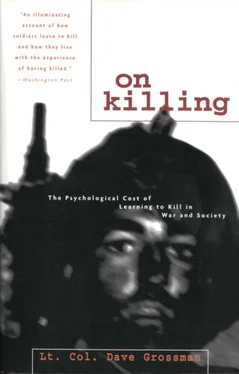Fatigue can quickly shift into the psychotic dissociation from reality that marks confusional states. Usually, the soldier no longer knows who he is or where he is. Unable to deal with his environment, he has mentally removed himself from it. Symptoms include delirium, psychotic dissociation, and manic-depressive mood swings. One often noted response is Ganzer syndrome, in which the soldier will begin to make jokes, act silly, and otherwise try to ward off the horror with humor and the ridiculous.
The degree of affliction in confusional states can range from the merely neurotic to the overtly psychotic. The sense of humor exhibited in the movie and television series M*A*S*H is an excellent example of individuals mildly afflicted with Ganzer syndrome. And this personal narrative provides a look at a man severely afflicted with Ganzer syndrome:
“Get that thing out of my face, Hunter, or I’ll feed it to you with hot sauce.”
“C’mon, Sarge, don’t you want to shake hands with ‘Herbert’?”
“Hunter, you’re f***ed up. Anybody who’d bring back a gook arm is sick. Anybody who’d bring one in the tent is begging for extra guard. You don’t know where that thing’s been. QUIT PICKING YOUR NOSE WITH IT! OUT, HUNTER! OUT!”
“Aw, Sarge, ‘Herbert’ just wants to make friends. He’s lonely without his old friends, ‘Mr. Foot’ and ‘Mr. Ballbag.’”
“Double guard tonight, Hunter, and all week. Goodbye, sicko. Enjoy your guard.”
“Say good night to ‘Herbert,’ everyone.”
“OUT! OUT!”
Black humor of course. Hard laughs for the hard guys. After a time, nothing was sacred. If Mom could only see what her little boy was playing with now.
Or what they were paying him to do.
— W. Norris “Rhodesia Fireforce Commandos”
Conversion hysteria can occur traumatically during combat or post-traumatically, years later. Conversion hysteria can manifest itself as an inability to know where one is or to function at all, often accompanied by aimless wandering around the battlefield with complete disregard for evident dangers. Upon occasion the soldier becomes amnesiatic, blocking out large parts of his memory. Often, hysteria degenerates into convulsive attacks in which the soldier rolls into the fetal position and begins to shake violently.
Gabriel notes that during both world wars cases of contractive paralysis of the arm were quite common, and usually the arm used to pull the trigger was the one that became paralyzed. A soldier may become hysterical after being knocked out by a concussion, after receiving a minor nondebilitating wound, or after experiencing a near miss. Hysteria can also show up after a wounded soldier has been evacuated to a hospital or rear area. Once he is there, hysteria can begin to emerge, most often as a defense against returning to fight. Whatever the physical manifestation, it is always the mind that produces the symptoms, in order to escape or avoid the horror of combat.
These states are characterized by feelings of total weariness and tenseness that cannot be relieved by sleep or rest, degenerating into an inability to concentrate. When he can sleep, the soldier is often awakened by terrible nightmares. Ultimately the soldier becomes obsessed with death and the fear that he will fail or that the men in his unit will discover that he is a coward. Generalized anxiety can easily slip into complete hysteria. Frequently anxiety is accompanied by shortness of breath, weakness, pain, blurred vision, giddiness, vasomotor abnormalities, and fainting.
Another reaction, which is commonly seen in Vietnam veterans suffering post-traumatic stress disorder (PTSD), years after combat, is emotional hypertension, in which the soldier’s blood pressure rises dramatically with all the accompanying symptoms of sweating, nervousness, and so on. [9] The cause of PTSD is associated primarily with the nature of the support structure the soldier receives upon returning to society from combat. This section is primarily concerned with the nature and etiology of psychiatric casualties occurring during combat. Post-traumatic stress disorder is a distinctly different type of psychiatric illness that will be addressed in detail in the section of this study entitled “Killing in Vietnam.”
Obsessional and Compulsive States
These states are similar to conversion hysteria, except that here the soldier realizes the morbid nature of his symptoms and that his fears are at their root. Even so, his tremors, palpitations, stammers, tics, and so on cannot be controlled. Eventually the soldier is likely to take refuge in some type of hysterical reaction that allows him to escape psychic responsibility for his physical symptoms. Character disorders include obsessional traits in which the soldier becomes fixated on certain actions or things; paranoid trends accompanied by irascibility, depression, and anxiety, often taking on the tone of threats to his safety; schizoid trends leading to hypersensitivity and isolation; epileptoid character reactions accompanied by periodic rages; the development of extreme dramatic religiosity; and finally degeneration into a psychotic personality. What has happened to the soldier is an altering of his fundamental personality.
* * *
These are only some of the possible symptoms of psychiatric casualties in war. Gabriel notes that “The mind has shown itself infinitely capable of bringing about any number of combinations of symptoms and then, to make matters worse, burying them deep in the soldier’s psyche so that even the overt manifestations become symptoms of deeper symptoms of even deeper underlying causes.” The key understanding to take away from this litany of mental illness is that within a few months of sustained combat some symptoms of stress will develop in almost all participating soldiers.
Treating the Mentally Maimed
Treatment for these many manifestations of combat stress involves simply removing the soldier from the combat environment. Until the post-Vietnam era, when hundreds of thousands of PTSD cases appeared, this was the only treatment believed necessary to permit the soldier to return to a normal life. But the problem is that the military does not want to simply return the psychiatric casualty to normal life, it wants to return him to combat! And he is understandably reluctant to go.
The evacuation syndrome is the paradox of combat psychiatry. A nation must care for its psychiatric casualties, since they are of no value on the battlefield — indeed, their presence in combat can have a negative impact on the morale of other soldiers — and they can still be used again as valuable seasoned replacements once they’ve recovered from combat stress. But if soldiers begin to realize that insane soldiers are being evacuated, the number of psychiatric casualties will increase dramatically. An obvious solution to this problem is to rotate troops out of battle for periodic rest and recuperation — this is standard policy in most Western armies — but this is not always possible in combat.
Proximity — or forward treatment — and expectancy are the principles developed to overcome the paradox of evacuation syndrome. These concepts, which have proved themselves quite effective since World War I, involve (1) treatment of the psychiatric casualty as far forward on the battlefield as possible — that is, in the closest possible proximity to the battlefield, often still inside enemy artillery range — and (2) constant communication to the casualty by leadership and medical personnel of their expectancy that he will be rejoining his comrades in the front line as soon as possible. These two factors permit the psychiatric casualty to get the much-needed rest that is the only current cure for his problem, while not giving a message to still-healthy comrades that psychiatric casualty is a ticket off of the battlefield.
Читать дальше







